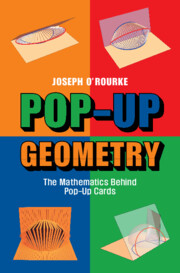'What a delight! Finally, a book that explains the geometry behind pop-up cards in a simple and straight-forward way with loads of illustrations and web animations to help. I look forward to sharing this gem with my own students.'
Thomas Hull - Western New England University
'Pop-Up Geometry is a beautifully written book. This book focuses on the aspect of pop-up structures of computational origami, a recent trend in computational geometry. Once you flip the pages, you will find various colorful figures. These figures nicely give you inspirations of paper art and ideas of the mathematical background of pop-up paper sculptures.'
Ryuhei Uehara - Japan Advanced Institute of Science and Technology
'There are many books about pop-ups, but only one about the mathematics of how they work. From analyzing standard pop-up mechanisms to advanced computational design, geometry master O'Rourke gives an excellent tour of this wonderful world.'
Erik Demaine - Massachusetts Institute of Technology
‘This text can readily be used as a supplement to a geometry course. I also see this book serving as a foundation for a multi-disciplined extracurricular activity called ‘Pop-Up Card Design’. This activity would encourage students interested in enhancing their skills in English, Mathematics, and Art as they work together in a cooperative effort to produce Pop-Up cards or Pop-Up books.’
Tom French
Source: MAA Reviews
'Complete with vibrantly colored graphics, companion animations that depict the motion described in the book, and templates for the reader to make the pop-up creations the book is analyzing, this book makes it easy for the reader to engage with the material they are learning.'
Katelynn Kochalski
Source: Notices of the American Mathematical Society
‘I can envision using this book as a text for a one-semester undergraduate interdisciplinary course that interweaves theory with physical constructions. Students would leave the course with a heightened sense of three-dimensional geometry, an appreciation of the creative potential of mathematics, and a portfolio of pop-ups to boot … This short (129 pages) book is engaging and inspiring, and it opens up a world of possibilities. It may even suggest a fresh and largely unexplored mathematical field: pop-up design and theory. It is going to generate a lot of activity, research, and design.’
Richard H. Hammack
Source: The Mathematical Intelligencer
‘A thought-provoking treasure trove of fun and intellectually challenging revelations that is accessible for a large mathematical audience.’
Source: Physics Book Reviews



